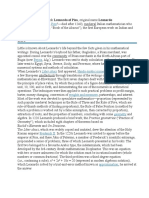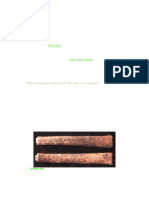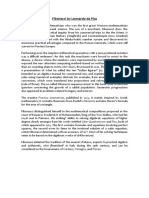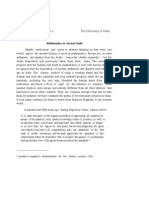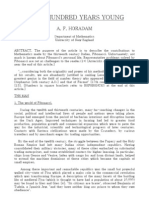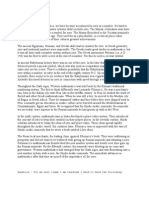The Fibonacci Sequence
The Fibonacci Sequence
Uploaded by
Missy Apelinga AtanqueCopyright:
Available Formats
The Fibonacci Sequence
The Fibonacci Sequence
Uploaded by
Missy Apelinga AtanqueOriginal Title
Copyright
Available Formats
Share this document
Did you find this document useful?
Is this content inappropriate?
Copyright:
Available Formats
The Fibonacci Sequence
The Fibonacci Sequence
Uploaded by
Missy Apelinga AtanqueCopyright:
Available Formats
The Fibonacci sequence, shows a numerical pattern.
This pattern's interest and significance beyond its
creator's expectations. It may model or describe phenomena in mathematics, science, art, and nature.
The golden ratio, spirals, and self-similar curves are all mathematical concepts that have long been
admired for their beauty, but no one knows why they are so clearly reflected in art and nature.
The history started in 1202 in Pisa, Italy. Leonardo Pisano Bigollo was a young man from a prominent
trading family in Pisa. The mathematical concepts that had come west from India via the Arabic
countries fascinated him throughout his East Asian travels. Returning to Pisa, he presented these ideas
in the landmark mathematical work Liber Abaci. Leonardo, known as Fibonacci, was the most famous
mathematician of the Middle Ages. His work was on mathematical methods in trade, but he is
recognized for two contributions, one major and one minor.
The important one: he introduced the Hindu numeric method to Europe. Modern mathematics would
not have been able without this alteration to the Hindu system, which we now call Arabic notation, as it
reached west over Arabic countries.
You might also like
- Mathematics in Medieval Europe: Presented By: Nur O. Amilin Bsed-Iii MathematicsDocument21 pagesMathematics in Medieval Europe: Presented By: Nur O. Amilin Bsed-Iii MathematicsDie A MuslimahNo ratings yet
- Biography of Leonardo Pisano BigolloDocument6 pagesBiography of Leonardo Pisano Bigolloapi-308622177No ratings yet
- History of Fibonacci NumbersDocument2 pagesHistory of Fibonacci NumbersHidayah MusaNo ratings yet
- The Fibonacci Sequence, Spirals and The Golden MeanDocument3 pagesThe Fibonacci Sequence, Spirals and The Golden Meanjai bachaniNo ratings yet
- Leonardo - Pisano - Fibonacci - 5 8498 4 - 64 9Document11 pagesLeonardo - Pisano - Fibonacci - 5 8498 4 - 64 9rnyhreyoudnfyavabtNo ratings yet
- Biography of Leonardo Pisano FibonacciDocument1 pageBiography of Leonardo Pisano FibonacciJoyce PocamasNo ratings yet
- Indians Hindu - Arabic Numeral System Place Value Numeral System BookkeepingDocument1 pageIndians Hindu - Arabic Numeral System Place Value Numeral System BookkeepingJohn Nheil Tavera JensenNo ratings yet
- Mathematician Person:: Isaac Newton and Wilhelm LeibnizDocument5 pagesMathematician Person:: Isaac Newton and Wilhelm LeibnizJc RicoNo ratings yet
- The Numbers of Nature: The Fibonacci SequenceDocument3 pagesThe Numbers of Nature: The Fibonacci SequenceLucky MalihanNo ratings yet
- My Favorate Mathematicians: Bigollo's Personal LifeDocument2 pagesMy Favorate Mathematicians: Bigollo's Personal LifeHerbert Shirov Tendido SecurataNo ratings yet
- Mathematics in Our WorldDocument7 pagesMathematics in Our WorldAllan T. BabadNo ratings yet
- Fibonacci The Numbers of NatureDocument5 pagesFibonacci The Numbers of NatureCindy ValdozNo ratings yet
- FibonacciDocument2 pagesFibonacciMerlan Faith CamachoNo ratings yet
- Life & Works of FibonacciDocument7 pagesLife & Works of FibonacciAllan T. BabadNo ratings yet
- FibonacciDocument5 pagesFibonaccijanvimadhaniNo ratings yet
- The Man of Numbers: Fibonacci's Arithmetic RevolutionFrom EverandThe Man of Numbers: Fibonacci's Arithmetic RevolutionRating: 4 out of 5 stars4/5 (14)
- Fibonacci SequenceDocument1 pageFibonacci SequenceApril Joy T. GrijaldoNo ratings yet
- FibonacciDocument8 pagesFibonacciJoao NunesNo ratings yet
- FibonacciDocument66 pagesFibonacciAndre McSwainNo ratings yet
- Fibonacci LiberAbaciDocument25 pagesFibonacci LiberAbacisandeeprainaNo ratings yet
- Delrosario Chloe FA1 Section27Document2 pagesDelrosario Chloe FA1 Section27JUSTINE CHLOE DEL ROSARIONo ratings yet
- Leonardo FibonaciDocument9 pagesLeonardo FibonaciLeonardo VinciNo ratings yet
- Math BsitDocument2 pagesMath BsitAngela Charisse GalaridoNo ratings yet
- FibonacciDocument2 pagesFibonacciSuelto, Cristel Jaycel R.No ratings yet
- History of Medieval European MathematicsDocument4 pagesHistory of Medieval European MathematicsAnthony Guevarra100% (1)
- Mem ResDocument11 pagesMem ResJennie DaluzNo ratings yet
- Untitled presentationDocument12 pagesUntitled presentationyranglani0No ratings yet
- Pisano (Aka: FibonacciDocument2 pagesPisano (Aka: FibonacciHaryo WawanNo ratings yet
- Module 2Document37 pagesModule 2Nina RkiveNo ratings yet
- Fibonacci by Leonardo Da PisaDocument2 pagesFibonacci by Leonardo Da PisaSusan Garcia GPNo ratings yet
- Leonardo Fibonacci Presentation Outline by JPTyreDocument4 pagesLeonardo Fibonacci Presentation Outline by JPTyreJohnNo ratings yet
- FibonacciDocument1 pageFibonaccimihalache1977No ratings yet
- Golden Ratio Binet's Formula: Liber AbaciDocument1 pageGolden Ratio Binet's Formula: Liber AbaciRaghav LadiwalaNo ratings yet
- FibonacciDocument3 pagesFibonacciSoke Cheng ThamNo ratings yet
- Fibonacci NumbersDocument12 pagesFibonacci NumbersChristelle Joy EusebioNo ratings yet
- Leonardo Fibonacci Mathematician (1170? - 1250? Pisa, Now Italy)Document12 pagesLeonardo Fibonacci Mathematician (1170? - 1250? Pisa, Now Italy)Andrea SantibañezNo ratings yet
- Kendriya Vidyalaya Mahuldiha, Rairangpur: Mathematics ProjectDocument12 pagesKendriya Vidyalaya Mahuldiha, Rairangpur: Mathematics ProjectBinapani PradhanNo ratings yet
- The History of Accounting Made by Julia HarbolinskaDocument13 pagesThe History of Accounting Made by Julia HarbolinskadonnaNo ratings yet
- JETIR1907Q94Document5 pagesJETIR1907Q94Nurul Dayati FauziahNo ratings yet
- Leonardo Fibonacci GleniceDocument3 pagesLeonardo Fibonacci GleniceMark Anthony TrasmonteNo ratings yet
- Fibonacci SequenceDocument10 pagesFibonacci SequenceYbanez CristopherNo ratings yet
- History of FibonacciDocument2 pagesHistory of FibonacciCorrimalNo ratings yet
- Mathematics in Ancient IndiaDocument6 pagesMathematics in Ancient IndiaSwanand RaikarNo ratings yet
- What Is The Fibonacci SequenceDocument4 pagesWhat Is The Fibonacci Sequencejai bachaniNo ratings yet
- Fibonacci - His Rabbits and His Numbers and KeplerDocument22 pagesFibonacci - His Rabbits and His Numbers and KeplerDwi AfriantiNo ratings yet
- Febonacci Series ProjectDocument24 pagesFebonacci Series ProjectAsthaNo ratings yet
- Digital Dragon: The Road to Nirvana Runs Through the Land of TaoFrom EverandDigital Dragon: The Road to Nirvana Runs Through the Land of TaoNo ratings yet
- FibonacciDocument13 pagesFibonacciNoel Dallow100% (2)
- Portfolio Stage 9.2Document3 pagesPortfolio Stage 9.25eshashankshukla12No ratings yet
- Biography ResearchDocument2 pagesBiography ResearchpauletalcazarinNo ratings yet
- Europian in The Medieval Renaissance and ReformationDocument33 pagesEuropian in The Medieval Renaissance and Reformationillumin24No ratings yet
- The History of ZeroDocument4 pagesThe History of ZeroPallavijoNo ratings yet
- History & MathsDocument14 pagesHistory & MathsAvril CutinhoNo ratings yet
- Development of Hindu NumeralsDocument1 pageDevelopment of Hindu Numeralsmanish.sukrtNo ratings yet
- Transmission of Islamic MathematicsDocument14 pagesTransmission of Islamic MathematicsmohammedNo ratings yet
- Explanation On Fibonacci SequenceDocument5 pagesExplanation On Fibonacci Sequencendossimichael29No ratings yet
- 101 Things You Didn't Know about Da Vinci: Inventions, Intrigue, and Unfinished WorksFrom Everand101 Things You Didn't Know about Da Vinci: Inventions, Intrigue, and Unfinished WorksNo ratings yet
- History of Mathematics & Its ApplicationsDocument18 pagesHistory of Mathematics & Its ApplicationsChie ChieNo ratings yet
- MedievalDocument41 pagesMedievalSalvador OrtegaNo ratings yet
- History of MathematicsDocument17 pagesHistory of MathematicsRosemarie AbacialNo ratings yet





















